QEEG Brain Mapping
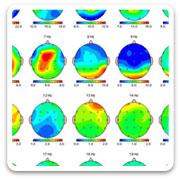 QEEG (Quantitative Electroencephalogram) Brain Mapping is a procedure that records electrical activity within the brain from 19 locations on the scalp. Very similar to the Electrocadiogram or EKG which measures electrical activity of the heart at the surface of the chest, the QEEG measures electrical activity of neurons or brain cells at the surface of the scalp.
QEEG (Quantitative Electroencephalogram) Brain Mapping is a procedure that records electrical activity within the brain from 19 locations on the scalp. Very similar to the Electrocadiogram or EKG which measures electrical activity of the heart at the surface of the chest, the QEEG measures electrical activity of neurons or brain cells at the surface of the scalp.
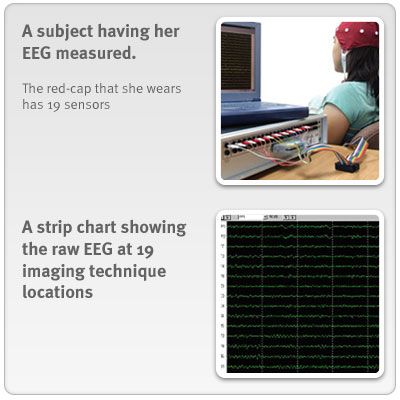 Brain Mapping is safe
Brain Mapping is safe
& non-invasive
QEEG is a safe and non-invasive assessment. Sensors are first placed on the surface of a person's scalp. Then, EEG activity is measured under different states and tasks that a person frequently encounters: eyes closed, eyes open, reading, writing, listening, and doing arithmetic.
What is it used for?
Over the years, neurologists have identified the functions of specific locations on the brain. For example, the Wernicke’s area was found to be involved in language, comprehension and intelligence. But we do not know if this location is active or not say during a reading task. A QEEG assessment will reveal the neural activities at this location while on a reading task. From our experience, we have seen this area shut down for many people while on a reading task. These people tend to have enormous reading difficulties or symptoms of dyslexia. If this area is too active, we find that it leads to symptoms of attention deficit.
The prefrontal area was found to be involved in planning complex movements and elaboration of thoughts. It is also involved in short term memory and logical thinking. We have seen that for people with learning difficulties, this location is either exhausted or shut down especially while on tasks such as solving a math problem. The prefrontal region is also involved in regulating our social behavior. All autistic children that we have assessed have prefrontals that are inactive. No wonder they have poor social skills and are not able to interact with others.
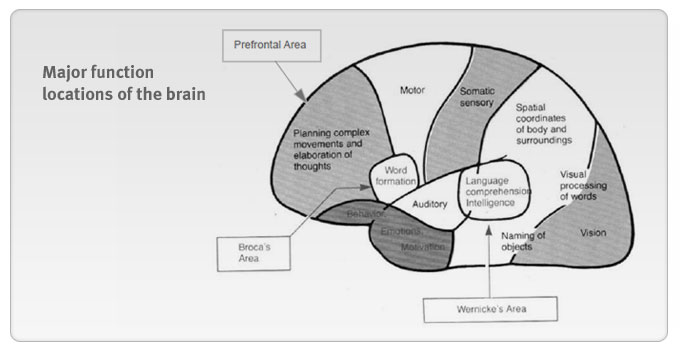
The QEEG assessment can be considered as a brain imaging technique. It tells us what the brain is doing. As we cannot see or feel what the brain is doing, a QEEG assessment willl provide an
invaluable picture of the state of our brain and how we are utilizing it. From the QEEG, we can assess:
- How one is regulating sensory information
- Areas that are over-active
- Areas that are fatigue or exhausted
- Areas that shut-down while on task
- Which regions of the brain are utilized for a task
- How each brain regions are working together
- The innate talent of a person in terms of brain function
At Spectrum Learning, we do not use the QEEG for diagnostic purposes. The main purpose is to understand the state of the brain and how one is utilizing his/her brain. With this information, we can then design a specific brain exercise program using neurofeedback. This leads to a more effective brain exercise. For example, those regions that are exhausted, we can train for recovery. For those areas that are weak, we can train to increase the neural activities. This tends to produce faster results.
Our QEEG Assessment is more elaborate than others...
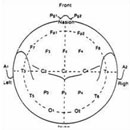 |
Number of electrodesStudies showed that a minimum of nineteen locations is needed for a reasonably accurate assessment of brain function. Many are using six electrodes or sixteen electrodes QEEG. At Spectrum Learning, we use nineteen electrode locations or thirty-two electrode locations. We are planning to increase our capability to the seventy-one electrodes. This will provide an elaborate map of the brain activities. |
 |
Spectral ChartsWe present our QEEG analysis using spectral charts where we can see the entire EEG spectrum. Other centers present their QEEG using topograhic charts. In topographic charts, the EEGs are banded into groups and averaged. This procedure results in lost of information. For example, from the spectral charts, we can see if the Alpha peaks are aligned and what the peak frequency is. This is not possible with a topographic chart. |
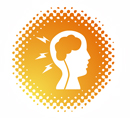 |
Multiple TasksAlmost all other center that provide QEEG do only eyes open and eyes close task. Some may include a reading task. Most of them will only look at the eyes opena dn eyes closed QEEG and attempt to derive neurofeedback protocols from there. We find that this is flawed. In our QEEG, other than eyes open and eyes close, we analyze the brain activities while the subject is doing a variety of tasks such as reading, recall, arithmetic, visual-spatial task, problem solving, music and etc. The type of tasks that we include depends on the needs of our clients. For those with mobility problems, we will include tasks which will allow us to assess the brain activities related to the problem. This multi-task approach allows us to better understand how one is utllizing his/her brain. |

